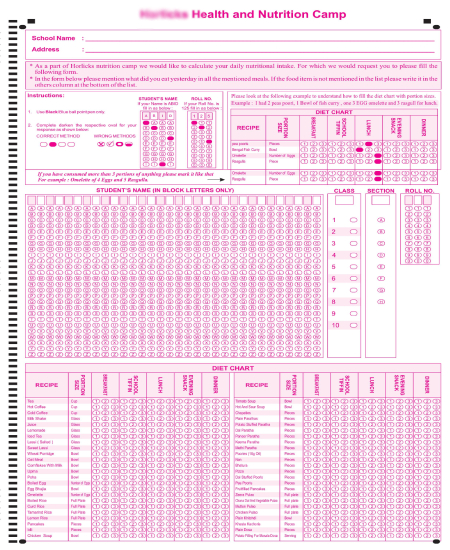OMR Sheets Designing


OMR Sheet Designing: Ensuring Accuracy and Efficiency
Our team has skillfully crafted over 10,000 OMR sheets for exams, surveys, hiring, appraisals, or various data gathering tasks, we offer top-level support and services, keeping the project details a secret. We make it easier for our customers to digest the activities that come after the main task, all with utmost security. We let clients customize their OMR sheets with diverse elements and information, to cater to particular task outcomes. Optical Mark Recognition (OMR) sheets are common in schools, test centers, surveys, and questionnaires. OMR sheet preparation carefully is vital; it helps collect data accurately and quickly.
Understanding OMR Sheet Designing
Creating OMR sheets design special forms that can be recognized by OMR scanners. These sheets feature circles or squares that the individual answering will shade in. The scanner then analyses these marked areas to collect data. It's crucial for these forms to be perfect to guarantee the gathered information is accurate.
Key Components of OMR Sheets
- Header and Instructions: The top section of an OMR sheet typically displays the title, offers instructions for properly completing the form, and contains critical identification elements such as names, student IDs, or test identifiers.
- Answer Areas: This key area is where individuals jot down their responses. It has circles or checks set up in rows or lines.
- Barcodes and QR Codes: To boost safety and speed up recognition, we could add these elements.
- Timing Tracks: These are dark squares or lines at the sheet's borders that signal the scanner the reply zone 's beginning and end.
Best Practices for OMR Sheet Designing
1. Clarity and ReadabilityFont Selection: Opt for plain, easy-to-read fonts. Stay clear of complex or overly ornate fonts that can be tough to decipher.
Instructions: Convey short, straightforward instructions to prevent any confusion that might lead to mistakes.
2. Layout and StructureConsistent Alignment: Go for a steady alignment of bubbles or checkboxes. It helps in the correct scanning and capturing of data.
Spacing: Leave good spacing between answer bubbles and other elements to stop overlaps and scanning blunders.
3. Marking AreasUniform Bubble Size: Keep bubble or checkbox sizes the same. If sizes differ, the scanner could get confused.
Adequate Margins: Make sure there's enough margin around marking spaces so no answer area gets cut off during scanning.
4. Use of ColorsMonochrome Design: Stick with a single color in design, ideally black, to ward off scanning mistakes.
Highlighting Instructions: When colors are used, check that they don't interfere with marking zones or timing paths.
Steps to Design an OMR Sheet
1. Define the PurposeStart by figuring out the OMR sheet's aim. Is it for a test, a survey, or gathering feedback? Getting this clear sets up your design task.
2. Choose a TemplateFind a template that fits your purpose. Templates offer a pre-arranged blueprint—they include all must-haves.
3. Customize the LayoutAdd Header and Instructions: Mention what the form is for, provide clear steps and include any ID info. Design Answer Areas: Lay out bubbles or checkboxes neatly. Keep them consistent in size and spacing. Include Timing Tracks: Set timing markers along the sheet borders to help the scanner track.
4. Test the DesignCheck your OMR sheet design with the scanning gear before the final touch. This helps catch any glitches and makes sure your design works with the equipment.
5. Finalize and PrintOnce the design is checked out and confirmed, complete the design and start to print. Make certain that your prints keep the initial design and are free of any warps. If you want a professional OMR sheet designer, consider Mark Reader.
Benefits of Well-Designed OMR Sheets
1. Accuracy in Data CollectionA carefully crafted OMR sheet guarantees pinpoint accuracy in data capture. Simple, straightforward instructions and correctly placed responses curtail mistakes in scanning.
2. Efficiency in ProcessingPrecisely structured OMR sheets allow for turbo-quick and smooth processing. This becomes important when it comes to broad-ranging exams or surveys where every tick of the clock counts.
3. Enhanced User ExperienceComprehensive and concise designs enhance user experience, simplifying the process for respondents to correctly fill the sheets. This cuts back on error possibilities and elevates the dependency of the data gathered.
Common Challenges in OMR Sheet Designing
1. Alignment IssuesIf bubbles or checkboxes aren't perfectly lined up, scanning mistakes might happen. Keeping alignment consistent is important to get precise data.
2. OvercrowdingPutting a ton of elements in a tight space makes the sheet messy and tough to read. Good spacing is a must.
3. Inadequate TestingNot checking the OMR sheet layout before wrapping up might bring unexpected hiccups during scanning. You have to test rigorously to make sure it works well with your scanning gear.
Creating OMR sheets matters in fields like education or studying markets. These Sheets need to be exact, easy, swift. You can craft them online or with specific programs. Key things to recall include: clarity, alignment, and full testing. A well-crafted OMR sheet collects correct information and boosts user interaction, ensuring everything functions reliably. Need to design OMR sheet online? Mark Reader is your answer. It's your all-in-one destination from creating to duplicating, digitizing, and even computing! Mark Reader guarantees smooth, mistake-free data collection. Discover their offerings and see how they can elevate your OMR tasks.